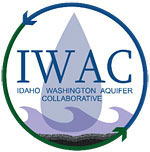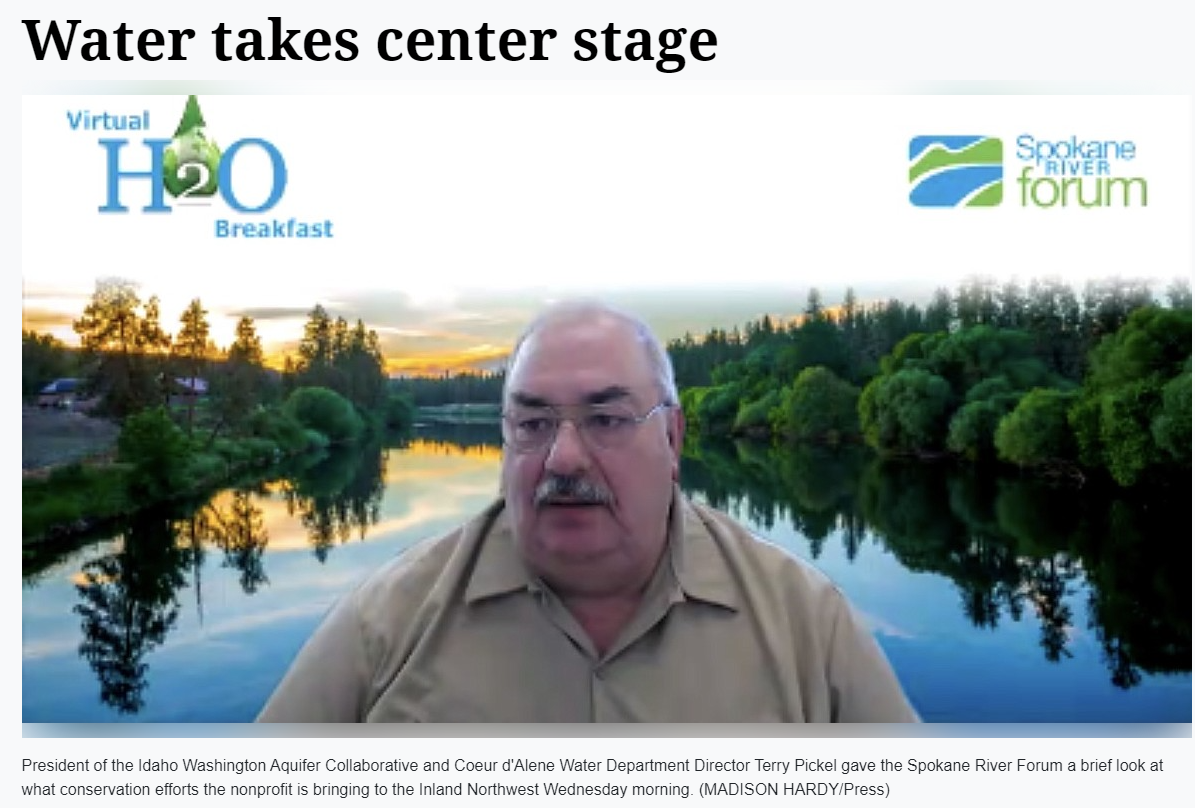Water Takes Center Stage – CDA Press Article
Staff Writer | April 1, 2021 1:07 AM
The Spokane Valley-Rathdrum Prairie Aquifer is a life-sustaining force to the Inland Northwest. Still, water conservation specialists say rising population across the Idaho Washington state line is straining the resource.
During the Spokane River Forum’s H2O Virtual Breakfast Wednesday, the president of the Idaho Washington Aquifer Collaborative and director of the Coeur d’Alene Water Department, Terry Pickel, described practices the community is employing to preserve the Spokane River while meeting the needs of a rapidly growing area.
The river is the largest contributor to the aquifer, according to the 2009 Spokane Valley-Rathdrum Prairie Aquifer Atlas, providing an average of 464 million gallons daily or 49% of the total aquifer inflow.
IWAC, a nonprofit organization, was established in 2013 to reduce consumption and promote better management of the Spokane Valley-Rathdrum Prairie Aquifer. The aquifer became the city of Spokane’s primary source of drinking water in 1908 and was placed under the highest level of protection by the Idaho Department of Environmental Quality in 1980.
Today, the aquifer provides water for drinking, cleaning, agricultural irrigation, wastewater treatment, and fire protection throughout the region.
Through IWAC’s combined Idaho and Washington staff, Pickel said the group has protected source water through stormwater measures, water quality, and preservation across state lines. Recently, Pickel and IWAC have been informing the public and elected officials about efficient irrigation and landscape design standards.
“I don’t know if most of you realize it, but most irrigation systems are only 30% to 40% efficient,” Pickel said. “So we’re wasting 60% to 70% of the water that you’re putting on your lawn.”
As a suggestion to public utility companies, appointed officials, and regional planning groups, IWAC set an initial goal of reducing water usage by 30%. While conservation specialists are well-versed in water usage trends, Pickel noted that many don’t see the issue and believe the aquifer has “plenty of water.”
“Well, California, Arizona, and Florida back in the 1930s, ’40s, and ’50s also said the same exact thing,” he said. “Look at where they are today. They have mandatory conservation efforts going on.”
There isn’t any hard “incentive” in having better practices, Pickel said. In fact, he noted there would be some costs associated with the shift. But it will have a significant impact on the future of the prairie and surrounding communities as a rising population demands preventive and regulative growth management plans.
“The objective is to improve the efficiencies that will help conserve water throughout the region,” Pickel said. “If we provide efforts to significantly reduce now, it will ensure adequate supplies for future generations.”
The Coeur d’Alene Parks Department is the single biggest consumer for irrigation under the city’s water department purview. As a whole, the city of Coeur d’Alene pumps just a little over 4 million gallons of water from the aquifer a year, Pickel said.
As a challenge, IWAC encouraged the parks department to reduce its consumption to achieve a better user rate. Through improved management practices — including moisture sensors and smart controllers — the department cut its water usage by 33% in 2019.
“I took this and put it together over one season just in Spokane County. You could provide water to the city of Coeur d’Alene for three and a half years,” Pickel said. “Just in one season … Imagine what we could do over the SVRP. It would be an enormous amount of water savings.”
Landscaping with low water plants and design elements can also help, he noted, pointing to SpokaneScape — a turf replacement rebate program for water customers in 2018. SpokaneScape encourages customers to replace turf with drought-tolerant plantings, efficient irrigation and mulch by offering up to a $500 rebate.
In Coeur d’Alene, the water and parks departments are experimenting with similar landscape projects like using white clover — a low-water, low-maintenance plant — at the Atlas Mill Site Park, swale installation along U.S. 95 and on Ramsey Road, and looking at planning and zoning changes with initiatives to reduce the necessity for green scape.
“The Northwest is a diverse and beautiful area. We have our unique climates, microclimates and need to design our landscape to fold in with what we look at and the beautiful river that we live our lives here,” Pickel said.




